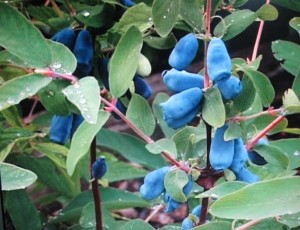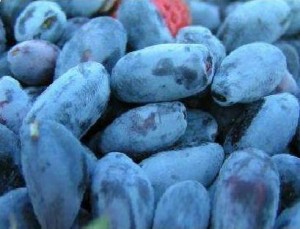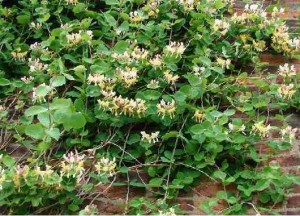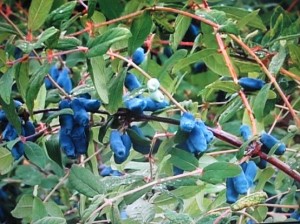
About 50 species of honeysuckle grow in our country. There is no need to describe each of them, especially since In our gardens, only edible and climbing, decorative varieties of this plant find practical use.
Edible honeysuckle grows everywhere in Siberia and the Far East. It deserves a more detailed description.
Description of edible honeysuckle
Edible honeysuckle is ideal for cultivation in northern regions. No cultivated plant can compete with it in terms of frost resistance. This shrub does not freeze in frosts below -50C, and even flowering honeysuckle can withstand temperatures dropping to -7C without losing the harvest.
Unfortunately, this amazing plant tolerates heat and dry climate much worse. Therefore, it is not widespread in the south of Russia.
When describing honeysuckle, one cannot fail to mention the amazing longevity of this shrub. It’s hard to believe, but even 100-year-old bushes retain the ability to bear fruit.
Another undoubted advantage of this culture is its precociousness. Already 2 - 3 years after planting, you can taste the first berries. The fruits begin to ripen in early June, or even at the end of May, showing an example of early ripening to other crops.
Describing the advantages of this culture, it should be said about some of its characteristic features. Honeysuckle is a cross-pollinated crop. This means that you need to plant not just a few bushes, but definitely several bushes of different varieties. Only if this condition is met will you be able to enjoy blue berries.
There is one more feature that worries many gardeners. The first two years after planting edible honeysuckle, the young bush practically does not grow. Don't worry, this is normal. It’s just that at the beginning its roots begin to grow actively, and after a year or two the above-ground part will begin to grow just as actively.
A description of the characteristic features would not be complete without mentioning that the bark of adult plants usually peels off. This is not a sign of a disease, but simply a biological feature of the species.
The fruits of wild honeysuckle are quite small. And although they have a pleasant taste, they are still noticeably bitter. Today, through the efforts of breeders, new large-fruited varieties have appeared. These varieties are very productive; 5–6 kg are harvested from one bush. large, up to 4 cm in length, berries. The taste of the berries is comparable to the taste of tropical fruits and is completely devoid of bitter aftertaste. It is when describing honeysuckle fruits that the expression “unique plant” is most often used.
Edible honeysuckle fruits, description of beneficial and medicinal properties
Honeysuckle berries are literally stuffed with the most valuable minerals and vitamins, and even collected in the optimal combination. In terms of the number of biologically active substances, it is on par with
And there is scientific confirmation and explanation for this. These blue and at first glance inconspicuous fruits contain the trace element selenium. This is a rare and extremely useful microelement for the human body. If you don’t go into medical details and describe it in a nutshell, it’s “an element of youth.” In addition to selenium, berries contain potassium, phosphorus, calcium, magnesium, manganese, iodine, sodium and a number of minerals and vitamins.
Traditional medicine has long and successfully used the miracle berry to treat atherosclerosis, anemia, hypertension, and skin diseases. And this is far from a complete description of the diseases that such an undemanding, but such a useful culture helps to fight. Not only the fruits, but also the buds, flowers, bark and leaves of this wonderful plant have unique medicinal properties. Even when frozen and dried, honeysuckle fruits retain all their beneficial properties.
Honeysuckle description of decorative qualities
It must be admitted that decorative varieties of honeysuckle are now rarely found in our gardens. Their 
Describing the advantages of honeysuckle, first of all, it should be said that it is very durable, grows quickly, can grow in the shade and is easily propagated by green cuttings. The ease of propagation allows you to quickly grow the required number of seedlings for growing hedges or landscaping gazebos and arches.
Hedges made from climbing honeysuckle are original and practical. They can be used in different ways. For fencing a site, for creating a green wall in the yard, and so on. And if you plant two different varieties, honeysuckle and Thälmann honeysuckle, the flowering will last for almost a month and a half. And even after flowering, numerous orange fruits will give your plantings a cheerful, elegant look.
Bush varieties of honeysuckle are also quite suitable for creating hedges. But here we must take into account that plantings planted in the shade and heavily thickened will become bare from below. The fence will have a neglected, unkempt appearance. To avoid this, you will have to pay more attention to plants growing in the shade. They need to be fed regularly and periodically thinned out to prevent them from becoming overgrown.
A detailed description of the cultivation and propagation of this crop can be found in the following article, called “Propagation of honeysuckle by cuttings”.
Jasmine bush planting and care



 CUCUMBERS NEVER GET SICK, I'VE BEEN USING ONLY THIS FOR 40 YEARS! I SHARE A SECRET WITH YOU, CUCUMBERS ARE LIKE THE PICTURE!
CUCUMBERS NEVER GET SICK, I'VE BEEN USING ONLY THIS FOR 40 YEARS! I SHARE A SECRET WITH YOU, CUCUMBERS ARE LIKE THE PICTURE! You can dig a bucket of potatoes from each bush. Do you think these are fairy tales? Watch the video
You can dig a bucket of potatoes from each bush. Do you think these are fairy tales? Watch the video
 How our fellow gardeners work in Korea. There is a lot to learn and just fun to watch.
How our fellow gardeners work in Korea. There is a lot to learn and just fun to watch. Eye trainer. The author claims that with daily viewing, vision is restored. They don't charge money for views.
Eye trainer. The author claims that with daily viewing, vision is restored. They don't charge money for views. A 3-ingredient cake recipe in 30 minutes is better than Napoleon. Simple and very tasty.
A 3-ingredient cake recipe in 30 minutes is better than Napoleon. Simple and very tasty. Therapeutic exercises for cervical osteochondrosis. A complete set of exercises.
Therapeutic exercises for cervical osteochondrosis. A complete set of exercises. Which indoor plants match your zodiac sign?
Which indoor plants match your zodiac sign? What about them? Excursion to German dachas.
What about them? Excursion to German dachas.
I had no idea that honeysuckle was such a healthy berry. I will definitely plant at least one bush
Veronika Sergeevna, unfortunately, honeysuckle cannot be planted one bush at a time. Honeysuckle is a cross-pollinated crop. To get a harvest, you need to plant several bushes of different varieties.
Is one bush enough to grow decorative honeysuckle?
Yes, you can grow decorative varieties of honeysuckle one bush at a time. This is just edible honeysuckle that needs to be planted in several bushes. This is necessary for pollinating flowers and obtaining a harvest.